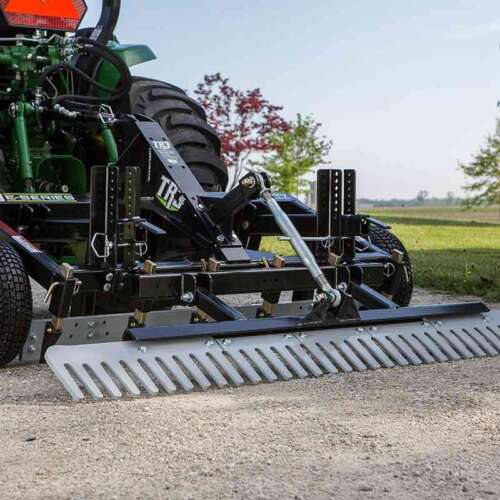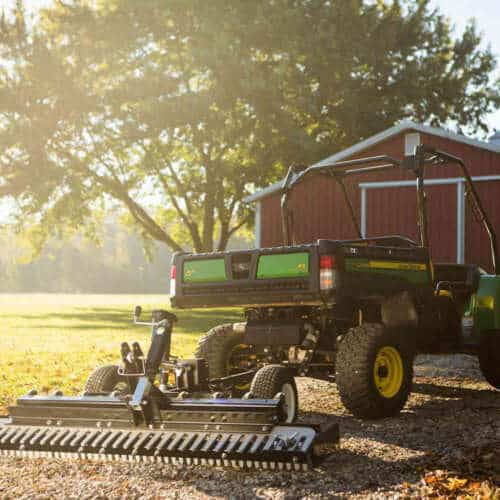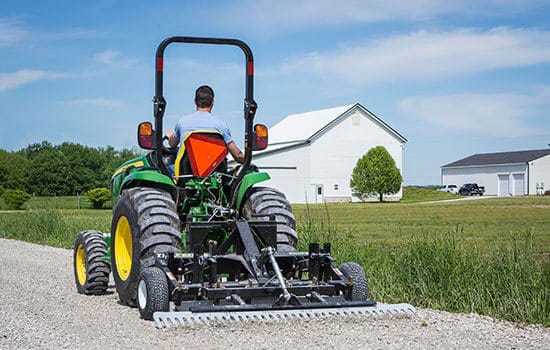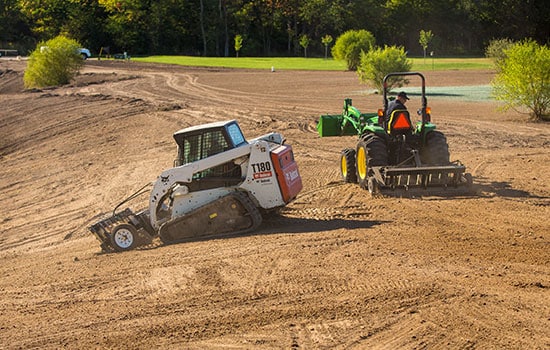Fixing a Gravel Driveway with Poor Drainage – ABI Dirt
Here’s What You Need to Know About Building Your Own Gravel Driveway.
Over the last few years, a number of folk have left the suburbs for the country. But in order to get their land looking like the country dream they imagined, for most, there’s a lot of work to be done. A common renovation project is turning a two-track trail into a real driveway so you can get to that beautiful house and property without killing your car’s suspension or chattering your teeth. Which means you have two options: invest a lot of money or a lot of time. To asphalt the driveway is the easier solution, it’s also far more expensive and simply not financially practical for many property owners. The alternative is to build your own gravel driveway.
ABI Products Shown In This Video


ABI Gravel Rascal Pro
- For ATVs, UTVs, & Sub-Compact Tractors
- 4.5', 5.5', 6.5', & 7.5' Widths
- Starting At: $94/mo.*
Transcript
How to Build a Gravel Driveway
You might be reading this blog because you’re wondering, “Can I install a gravel driveway myself?” Whether you’re looking to cut costs or you just want a new challenge, the answer is yes. Yes, but you need the right equipment. If you have a tractor or a skid steer then you just need the right driveway attachments to get the job done. And if you don’t own your own equipment and aren’t ready to buy, you can always rent from your nearest equipment rental yard. The final piece you need is the knowledge of how to build a gravel driveway from the ground up. And how to do it in a way that will get you successful, lasting results.
The Shape of Your Driveway
Before you ever move one particle of dirt, you need to decide whether your gravel driveway is going to be sloped or crowned. Why is this so important? If you build a gravel driveway that doesn’t shed rainwater, you might as well not build it at all. If water doesn’t shed, you’ll end up with a soft, pothole-filled disaster that will need an incredible amount of maintenance and annual replenishment of gravel. You’ve got to get rid of the rain.
Most contractors will tell you to crown your driveway, because when the center of the gravel driveway is the highest point, the water will shed in both directions which gives the water the shortest distance to travel and thus reduces erosion. This is true, and in many cases the best option. However a crown can produce more maintenance needs long-term. Even the best built gravel driveway will need some pothole and grading maintenance from time to time. Fixing potholes and loosening and regrading the gravel driveway while still keeping the original crown intact can be difficult. Especially when property owners are often using a box scraper or a rear blade, both of which inevitably cut the crown right out of the gravel driveway, thus leaving nowhere for the rain to go.
A one-slope driveway with a 1/2” to 3/4’” slope going from the highest side of the driveway to the lowest side of the driveway might work better for simplicity’s sake or if your driveway shape isn’t compatible for a crown–if the surrounding landscape, for instance, has an existing slope. Although this forces the water to move a further distance which can cause erosion, it is easier to maintain.
The Layers of a Gravel Driveway
Building a sturdy and reliable gravel driveway with the least amount of long-term maintenance requires two layers.
- Bottom Layer: A gravel driveway base layer made from a component such as a very fine aggregate with some fines in it so it compacts well, will hold up to the weight of years of vehicles and reduce the depth of potholes. In general terms this could be a stone aggregate that’s particle size is less than a quarter inch and that has approximately 25% broken down fines. Ultimately, you want between eight and ten inches of this material for what is typically called the base of the driveway. To install the base, put down two inches of the aggregate, wet it, then compact the layer.
- Top layer: Once the base layer is dry and solid, add the top layer of larger gravel until you reach your desired depth. You want your top layer to be able to take the direct impact of the tires of your vehicles. Most local quarries will have a road gravel that will work just fine– stone approximately ¾ inch in diameter that has very little fines to it.
Keeping Your Gravel Driveway in Good Condition
Once you’ve got the gravel driveway or gravel road built, the ongoing maintenance is key to keeping the gravel in great condition. Nothing destroys a gravel driveway quicker than water that cannot get away. This is why we went over crowns and slopes before jumping into the actual installation process. Because it’s so vital to get rid of the rainwater and not let it sit on the gravel driveway, one of the ongoing gravel maintenance steps regularly needed is to keep the grass edge of the gravel driveway cut down, so a large lip doesn’t build up.
With every gravel driveway, no matter how well built, potholes are still inevitable. However, there will be fewer of them if you properly grade and maintain the edge of the gravel driveway. But for the ones that still manage to spring up, how do you get rid of them? The most common practice for getting rid of a pothole is to simply pull loose gravel into the hole and try to pack it down. This may sound easy, but unfortunately, it’s also essentially useless. The next time a vehicle drives over that pothole, it will push the loose gravel right back out and within days, you will have the same old pothole.
If you want to eliminate your potholes, break up the rim of the pothole all the way to the very bottom. Breaking up the compaction helps ensure the pothole won’t return. Property owners have gotten creative to break up their potholes, using pickaxes, claws of hammers, or even crowbars. While those methods have the potential to eventually work, if you have an ATV/UTV, tractor, or skid steer all you need is a quality attachment to make quick work of getting to the bottom of the pothole.
Looking for the right equipment to make your gravel driveway project a reality? Check out our top-of-the-line driveway grading attachments or talk to an expert today at 877.788.7253.



